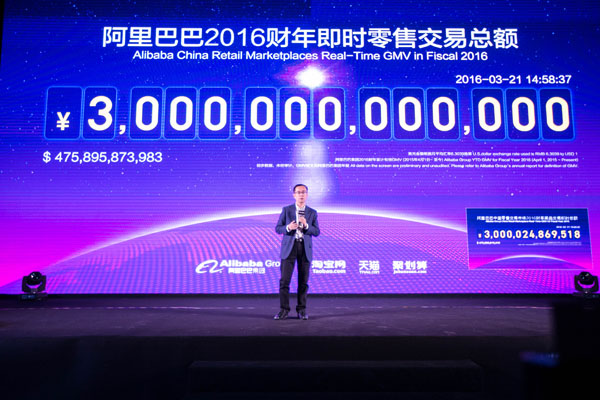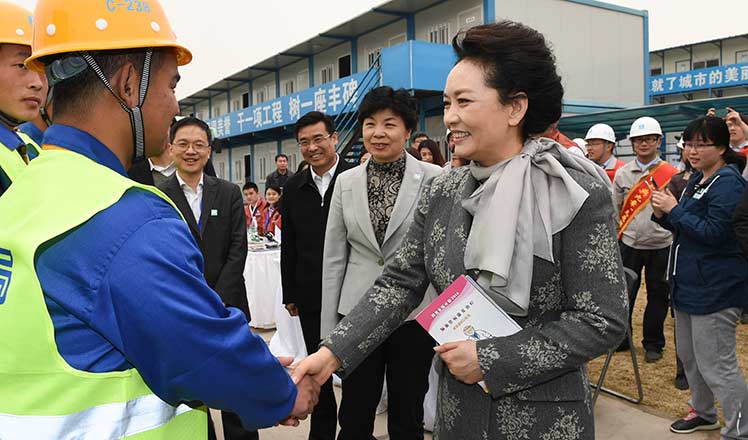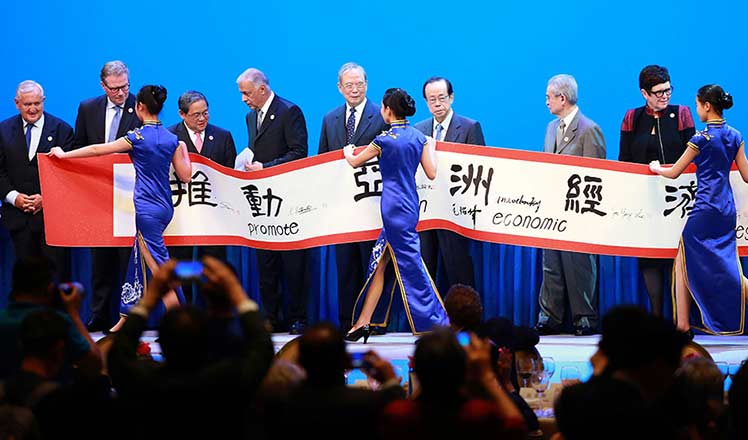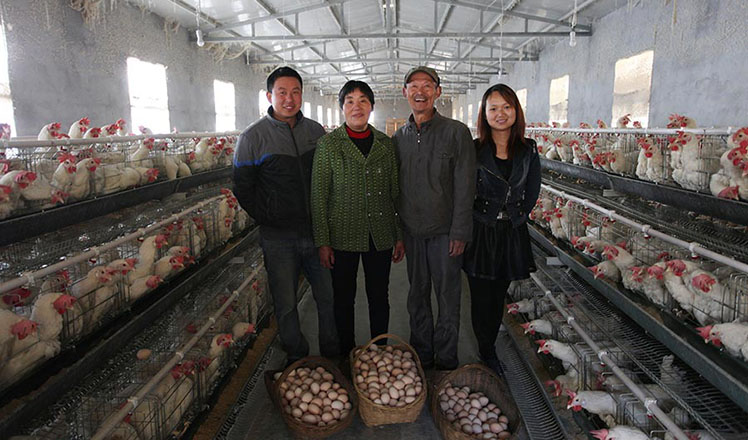Enterprises lined up for supply-side attention
Updated: 2016-03-25 22:30
By Andrew Moody(China Daily USA)
|
||||||||
 |
|
Alibaba Group announced on March 21 that its total trading volume in the current fiscal year exceeding 3 trillion yuan ($463.3 billion). Private sector which boasts companies such as Alibaba, enjoy growth than State-owned enterprises. |
The use of the term supply-side has brought up the parallels with the Reaganomics of the 1980s, which along with Thatcherism in Britain, fundamentally altered the course of post-war economic policy in the West.
Out went the Keynesian policies that had largely consisted of fiscal policy to control the level of aggregate demand in the economy with the aim of maintaining full employment but had resulted in stagflation (low growth and inflation), and in came free-market policies embracing Chicago school monetarism that had originated in the 1950s but had become particularly prominent in the 1970s.
A key element of this in the United States was tax cuts and deregulation, and a landmark event was Reagan's 1981 Budget, in which he reduced the marginal tax rate for high earners from 70 percent to 50 percent.
Paul Craig Roberts, who was assistant secretary in the US Treasury at the time and who has given an address to Chinese leaders on supply-side economics in Beijing, believes there are parallels between what happened in the US then and the challenges facing China now.
"Supply-side economics entered the scene (in the US), because the Keynesian policymakers had no answer to the worsening tradeoffs between inflation and unemployment," he said. "In short, to combat inflation within the demand management model was requiring higher rates of unemployment, and to boost employment was requiring higher rates of inflation."
Roberts, author of The Supply Side Revolution: An Insider's Account of Policymaking in Washington and who has had his books translated into Chinese, said that what China is trying to deal with is not stagflation but high debt.
He said leading Chinese thinkers in this area such as Jia Kang, president of the China Academy of New Supply-side Economics, the leading think tank, realize they have to change the economic model, which has relied on boosting consumption and investment with cheap money.
"In other words, an extraordinary amount of income is diverted away from the demand for goods and services and from real business investment (as opposed to investment in financial instruments). The financial empires built by debt finance are draining the Chinese economy of the ability to grow," he said.
Foreign multinationals in China have welcomed China's supply reforms because they believe an upgrading of the economy will benefit their businesses.
Gaby-Luise Wuest, managing director of Infiniti China, the luxury division of Japanese carmaker Nissan, believes it will be good for the premium car market in the longer term. "Supply-side reform requires companies to focus more on innovation, and therefore provide opportunities for innovative manufacturers," she said.
Zhang Ying, managing director for Greater China for Dassault Systemes, the French multinational software company, thinks such an approach will drive the development of technologies such as cloud computing, big data, the Internet of Things and 3-D printing. "As far as I am concerned, supply-side structural reform will leverage all effective ways to improve business processes, ranging from research and development to sales and marketing."
Huang Chenhong, president, Dell Greater China, believes that if supply-side reforms are successful, it will create a better business environment in which to operate.
"Supply-side reform, which encourages tax cuts, entrepreneurship and deregulation will increase technological revolution and high-quality goods and services," he said.
Zhu, also author of the recently published China's Guaranteed Bubble, which looks at some of the risks within the Chinese economy, believes China's weakness is not on the supply side but on the demand side of the economy and this is what the government should deal with.
He said the problem in both the US and the UK 30 years ago was very different from what it is in China today. "In both cases the demand side was strong enough but there wasn't enough incentive for companies to produce what the demand side desired. If supply lagged behind demand you had a continual risk of inflation."
However, Xu at CEIBS insists that China is not blindly following some old model of supply-side reform and is also aware of some of the failings of Reaganomics and Thatcherism that eventually led to increasing income inequality.
"I think they want to learn from the Western supply-side policies and generate some spirit of increasing efficiency by freeing the private sector but not to the degree that is going to negatively affect the working class," he said. "China wants to raise efficiency while actually reducing the income inequality gap."
Contact the writer at andrewmoody@chinadaily.com.cn
Supply-side timeline
18th century
Intellectual origins based on the writings of classical economists Adam Smith and David Hume.
1803
Jean-Baptiste Say (1767-1832), in his A Treatise on Political Economy, came up with Say's Law, which has been interpreted as "supply creates its own demand".
1950s
The Chicago school of economists including Nobel laureate Ronald Coase and, more famously, Milton Friedman, challenged the then Keynesian orthodoxy of demand management policies that influenced much of the thinking of Western governments. They argued that governments should let free markets operate and that their only role was to control money supply, hence the term monetarist.
1970s
There is debate about whether the term supply-side economics was first used by the journalist Jude Wanninski or by Herbert Stein, a former economic adviser to president Richard Nixon.
Late 1970s
While teaching in California, economist Arthur Laffer developed his theory, later known as the Laffer Curve, which illustrated that tax revenues could fall if tax rates rose above a certain point. His work proved highly influential in the development of Reaganomics.
1980
Reaganomics. Ronald Reagan was elected in 1980 and pursued a tax-cutting and deregulation agenda that was largely built on a new supply-side and monetarist approach.
1980s
Thatcherism. British Prime Minister Margaret Thatcher was influenced by Austrian economist Friedrich Hayek, who was not a fan of modern supply-side economics. Nonetheless, her curbing of trade union powers and privatization of nationalized industries are seen as significant supply-side measures.

 First lady Peng Liyuan leads fight against tuberculosis
First lady Peng Liyuan leads fight against tuberculosis
 Faces at Boao Forum for Asia Annual Conference
Faces at Boao Forum for Asia Annual Conference
 In photos: Lunar eclipses visible in eastern China
In photos: Lunar eclipses visible in eastern China
 Chinese chasing Spring blossoms around the country
Chinese chasing Spring blossoms around the country
 Migrant couple returns to hometown to raise chickens
Migrant couple returns to hometown to raise chickens
 Victims of Brussels attacks commemorated
Victims of Brussels attacks commemorated
 In photos: Brussels rocked by multiple explosions
In photos: Brussels rocked by multiple explosions
 Raul Castro and Obama hold talks in Havana
Raul Castro and Obama hold talks in Havana
Most Viewed
Editor's Picks

|

|

|

|

|

|
Today's Top News
Marriott unlikely to top Anbang offer for Starwood: Observers
Chinese biopharma debuts on Nasdaq
What ends Jeb Bush's White House hopes
Investigation for Nicolas's campaign
Will US-ASEAN meeting be good for region?
Accentuate the positive in Sino-US relations
Dangerous games on peninsula will have no winner
National Art Museum showing 400 puppets in new exhibition
US Weekly

|

|








